If you are considering completing a medical assistant program then you’re likely wondering, where can medical assistants work? Then this article will give you 20 awesome ideas of places that medical assistants can work.
The list doesn’t just include where most medical assistants work, our list also includes some medical assisting jobs that are not so commonly known.
So, even if you have already been researching for places that medical assistants can work, this list should give you some new ideas.
Specialized Clinics
Outpatient Clinics
Ophthalmology Clinics
Clinical Labs
Chiropractic Unit
Obstetrics & Gynecology
Primary Care Facilities
Emergency Departments
Specialized Clinics
EKG/Cardiology Facility
Retirement Communities
Palliative Care Facility
Orthopaedic Clinics
Psychiatric & Behavioral Health
Radiation Oncology Center
Podiatry Clinics
Adminstrative & Military
Medical Billing & Coding
Administrative Assistance
U.S. Army
U.S. Navy
U.S. Air Force
U.S. Coast Guard
Jobs For Medical Assistants That Are Clinically Specialized
There are a wide variety of speciality physicians and clinics that medical assistants can work for. Below are 14 common and lesser known specialized clinical areas that medical assistants can work in.

#1: Outpatient Clinics
According to the BLS there are just over 50,000 medical assistants employed in outpatient clinics. In an outpatient clinic that is run by a specialist doctor, medical assistants have to do a number of jobs.
It may vary from greeting the patients at the entrance to making phone calls, do the front-desk operations, performing different clinical tasks associated with the patient like drawing blood and dressing up wounds, set up and organize further appointment for the patient if necessary, instruct patients about precautions and special diets if any, general care, etc.
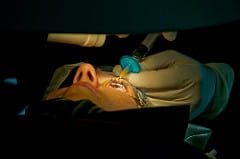
#2: Ophthalmology Clinics/Optometric Assistants
Medical assistants employed in these facilities provide eye care. At the optometrists’, they teach patients how to insert, remove and take care of their contact lenses. At ophthalmology clinics, they assist in minor eye surgery.
They help to administer medications to the eye and help the ophthalmologist in emergencies. Optometric medical assistants can get credentialed by the Joint Commission of the Allied Health Personnel in Ophthalmology (JCAHPO).
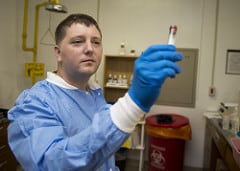
#3: Clinical Labs
A good part of a medical assistant’s job in a laboratory facility involves the collection, preparation, classification and processing of samples. They also need to be conversant with conducting all types of lab tests.
They should have basic skills in collecting blood samples and support the senior lab staff in their work. Labs that are unaffiliated to primary healthcare units also employ medical assistants, though it may be less common.
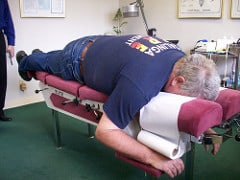
#4: Chiropractic Unit
Chiropractors hire medical assistants that are knowledgeable about how to handle patients complaints using massage and body manipulation. The job for beginner assistants includes hands-on training in various massage techniques and body parts manipulation and assisting the chiropractor in different patient treatments.
However, medical assistants may also have to do administrative work that includes taking down the patient history, educating the patient about procedures, setting up further appointments and handling insurance issues.

#5: Obstetrics and Gynecology Facility
There is no formal certification for medical assistants that work in obstetrics and gynecology facilities. However, doctors look for a basic certification by the American Association of Medical Assistants.
Medical assistants have to undergo plenty of hands-on training and build their skills adequately for good performance. Working with women, both young and old, is a basic requirement. Medical assistants assist the gynecologist/obstetrician in conducting breast exams, Pap smears, care of pregnant women, assisting the main doctor in minor surgeries and procedures.
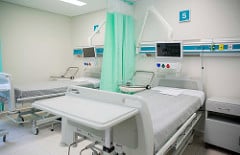
#6: Primary Care Facilities
Medical assistants are employed in primary care facilities such as clinics or hospitals and urgent care clinics to assists doctors and nurses in their jobs. They are required to do clinical jobs and are sometimes involved in administrative tasks as well.
Medical assistants typically assist the physician by recording the patient history and information, measure and record vital signs are blood pressure and heart rate, help in administering injections and medication, change dressings, instruct patients about special diets, schedule patient appointments, removing stitches, assist the doctor while performing patient exams, and enter the patient information as medical records among other jobs.
They can also work in the patient registration department and reception to organize patients’ details. Alternately, they can assist doctors in transcription of their notes if they are trained in that direction.
We have more info and pictures of medical assistants working in hospitals.
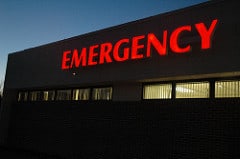
#7: Emergency Departments
Often reporting to a Nurse Director or Emergency Physician, medical assistants working in emergency departments have a global view of the Emergency Department’s evaluation area and the pre-evaluation waiting area.
Medical assistants will be required to support incoming patients, the clinic’s medical staff and other members of the care team. When working in an emergency department, it will be extremely important for medical assistants to provide efficient health care services. You can see more images and learn more about emergency medical assistants here.
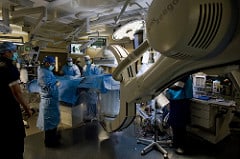
#8: EKG/Cardiology Facility
Medical assistants can specialize as cardiology technicians if they have an interest in the subject. They assist the cardiologists by doing the EKGs on patients, using the Holter monitor and conduct stress tests on them.
To work as a medical assistant in a cardiology facility, the medical assistant may be required to undergo special training after completion of the medical assistant course. Hands-on training by the employer serves just as well.
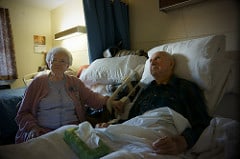
#9: Retirement Communities
Medical assistants are in great demand among members in retirement communities. Residents often need medical assistance due to the fact that they may not be infirm. Their care is best provided by medical assistants.
Medical assistants working in retirement homes would need some special training in geriatrics after graduating from medical assistant school. Medical assistants employed here are typically trained to administer injections, provide wound care, administer medications, help the residents to move around or handle day to day tasks if injured, handle basic physiotherapy sessions, handle emergencies, and to provide first aid.
Most of the residents living in retirement communities have their own medical specialist doctors and consultants that the medical assistant may interact with and assist.
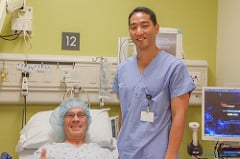
#10: Palliative Care Facility
Palliative care facilities employ medical assistants who will assist the patients affected with cancer are who are terminally ill. These patients often require care and assistance daily.
The medical assistant will typically follow the oncologist’s instructions for administering medications, dressing up wounds and changing dressings, meeting the patients’ relatives and informing them of the course of actions to be taken, etc.
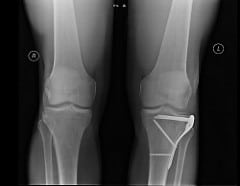
#11: Orthopedic Clinics
An orthopedic, or orthopaedic, clinic specializes in treatment of the musculoskeletal system offering specialized treatment for complex trauma and bone fractures as well as ankle and foot diseases and conditions. Medical assistants working in an orthopedic clinic will be responsible for greeting and escorting patients safely around the clinic and assisting the physician with their patient exams and procedures.
Duties include suture removal, injections, cast removals and more. The ability to take vital signs and obtain accurate temperature, respiration, pulse, blood pressure, height and weight measurements is required.
Preparing medications and treatments that are in accordance with the FPMG policy and procedures and nursing standards will be required. Additional duties may include keeping exam room stocked with medical equipment and supplies as well as disinfecting tables, counters, and other tools and equipment.

#12: Psychiatric & Behavioral Health
Sometimes a mental health assistant is required to obtain their CNA but other times a CMA will suffice. There are a number of different types of behavioral health patients a medical assistant could work with such as patients recovering from addiction or substance abuse. Some job responsibilities include:
- Treatment Planning
- Patient Assessment
- Medical & Psychiatric Care
- Stabilization During Crisis
- Intensive Treatment
- Education of Patient & Family
- Discharge Planning
- Addiction Counseling
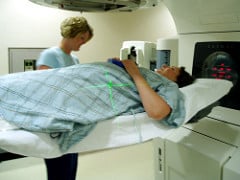
#13: Radiation Oncology Center
Medical assistants can work in radiation oncology centers. Similar to palliative care facilities, these medical assistants will assist cancer patients. Specifically, they will assist patients undergoing radiation treatment. They often have both front and back office responsibilities and some of the special skills required include:
- Providing care based on individuals specific needs including age
- Following detailed instructions to treat patient information appropriately and confidentially
- Communicating clearly both verbally and in writing
- Working well under pressure and on a team with other medical staff

#14: Podiatry Clinics
In podiatry clinics, medical conditions of the foot are treated. Medical assistants working in Podiatry clinics need to be certified by the American Society of Podiatric Medical Assistants.
Their job includes assisting the doctor with splints and casts, trimming the toenails of patients, cleaning of wounds, minor surgery and develop x-rays.
Medical assistants working in Podiatry clinics may perform tasks such as applying creams to get rid of excessively dry feet or using a pumice stone on a patient’s callus.
Medical Assistant Jobs for those That Have Administrative Specialties
Some medical assistants are specialized for administrative duties as opposed to giving treatment. The jobs below are available specifically for these administrative medical assistants. The general responsibility of these positions is to keep patient records organized and maintain the front office.
#15: Medical Billing and Coding
Another area where medical assistants can work is the billing and coding section of a hospital. Medical assistants can be trained to become medical coding professionals.
The primary job of medical billing and coding professionals is the preparation of charge sheets and their submission to insurance companies for reimbursement. Every meeting with the doctor is recorded by the medical assistant and all details are noted. The doctor would use the charge sheet as evidence as to what was done during the patient’s visit. Insurance companies use charge sheets to calculate the amount to be paid by the patient to the physician.
Medical coders need thorough knowledge of Medicare as they would be working directly with the service providers. Certification for medical billing and coding may be obtained from the AAPC or BMSC. Medical assistants may also specialize in ambulatory care or hospital coding.
#16: Administrative Assistance
Medical assistants may be involved in plain administrative assistance. In such a case, the professional works closely with the hospital administrator or the hospital management team.
Duties would include recording of specific values/details pertaining to all administrative functions, feeding them into reports and creating spreadsheets of graphs for interpretation. Every meeting would require the medical assistant to take down relevant notes.
The MA would have to be clear about the hospital’s policies and help to ensure they are followed. Administrative capabilities grow with the passing years of experience for the medical assistants.
Military Medical Assistants
Military Medical Assistants, except for in the Coast Guard, do not need to obtain a 2-year degree like civilian medical assistants. However, they must complete basic training plus additional training specialized to whichever military branch they serve in. In the Coast Guard, you must already be a qualified physician assistant to become a medical assistant and you can then skip basic training.
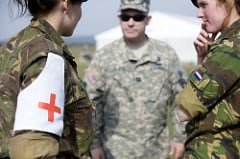
#17: Medical Assistants in The U.S. Army
The U.S. Army trains enlisted men and women to work with nurses and doctors in hospitals in bases and on the battlefield. These medical assistants are called Health Care Specialists and they have the opportunity to be deployed anywhere in the world.
They’re required to complete the Armed Services Vocational Aptitude Batter (ASVAB) sub-tests scoring a minimum of 95. As the army’s military medical assistant, health care specialists should have an interest in helping others, good communication skills, and a high math and science aptitude.
In regards to training, you must complete 9 weeks of basic training and an additional 16 weeks of specific training for health care specialists. You will have much opportunity to work up through the military ranks, and could even obtain a chief medical non-commissioned officer rank.
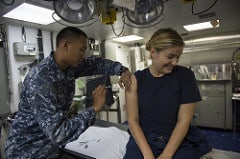
#18: Medical Assistants in The U.S. Navy
Navy Medical Assistants are known as Hospital Corpsman. They provide medical and dental care to marines and sailors. A Hospital Corpsman also provides a range of medical services in various settings depending on deployment they could work on base, a ship, or in a war zone with marines.
These medical assistants also care for Navy SEALs and may be deployed remotely with them on their missions. Corpsman are enlisted service members and receive specialized training to perform their duties. They are also required to complete basic training and must obtain a score of at least 149 on the ASVAB tests.
It should be noted that only male hospital corpsman are deployed along with Marines in battle.
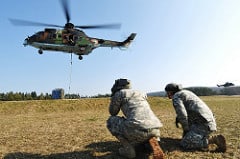
#19: Medical Assistants in The U.S. Air Force
In the Air Force, medical assistants are called Physicians Assistants. Due to the small size of the Air Force compared to other military branches, it can be competitive to become a Physician Assistant.
It is required that you score at least a 44 on the general sciences of the ASVAB tests. Enrolling in or completing a physician assistant program will also help you have a competitive advantage over your peers.

#20: Medical Assistants in The U.S. Coast Guard
This is the smallest and most competitive branch of the military simply because there are the least medical assisting positions available. Like the Air Force, medical assistants in the Coast Guard are referred to as Physician Assistants.
You must be qualified as a physician assistant in the civilian world when applying to become a military medical assistant for the Coast Guard. Unlike other military medical assistants, in the Coast Guard, you will be a commissioned officer. You will be offered direct commissions as an officer and do not need to go through basic training.
Conclusion
There you have it, 20 awesome places where medical assistants can work. Some of these are common places where most medical assistants work but some of them you probably hadn’t heard of before.
So, now you don’t need to ask where can medical assistants work? You should be asking, how can I get started with my medical assisting career?
We are glad you asked 😉
Get started by reading our Medical Assisting Frequently Asked Questions and asking our community any questions you have about starting your medical assisting career.
According to the Bureau of Labor Statistics (BLS) the medical assisting profession will remain one of the fastest growing occupations through 2020. Medical assisting is expected to grow about 35% in the next 5 years.



